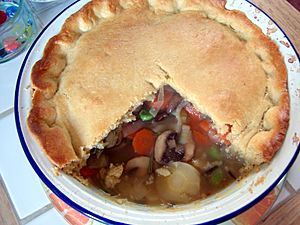Woolton pie facts for kids
Woolton pie is a tasty vegetable dish that became very popular in Britain during the Second World War. At that time, food was rationed, and it was hard to find many ingredients, especially meat. This pie helped people eat healthy meals even with limited food supplies.
The pie was created at the famous Savoy Hotel in London by a chef named Francis Latry. The British government's Ministry of Food even suggested this recipe to the public. It was named after Frederick Marquis, Earl Woolton, who was the Minister of Food starting in 1940. He helped make the recipe well-known across the country.
How to Make Woolton Pie
Woolton pie is made mainly from vegetables. The main ingredients are usually diced (cut into small cubes) potatoes, cauliflower, and carrots. Sometimes, parsnips or turnips were also added. People could use any other vegetables they had available at the time.
To make the filling, rolled oats and chopped spring onions were mixed into the thickened water from cooking the vegetables. This mix was then poured over the cooked vegetables. The pie was topped with a pastry crust made from potatoes, and sometimes grated cheese was sprinkled on top. It was often served with a simple vegetable gravy. A great thing about this pie was that the filling could be changed easily to use whatever vegetables were in season.
Why Was It Important?
During World War II, Britain faced serious food shortages. Many foods, especially meat, sugar, and butter, were rationed. This meant each person could only buy a small amount of these items. The government encouraged people to grow their own food and use simple, nutritious recipes.
Woolton pie was a perfect example of a "wartime recipe." It used vegetables that were easier to find and helped families get important nutrients without needing expensive or rationed ingredients. It showed how people could be creative and resourceful during difficult times.
Where to Find the Recipe Today
Even after the war ended, the recipe for Woolton pie has been published many times. It often appears in cookbooks that celebrate important anniversaries, like 40 years after the end of the war. For example, Marguerite Patten included it in her 1985 book We'll Eat Again. This shows that Woolton pie remains a part of British history and cooking.


